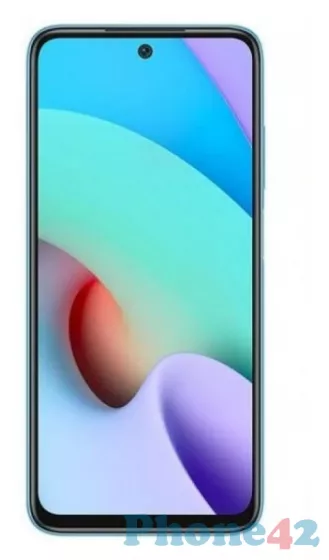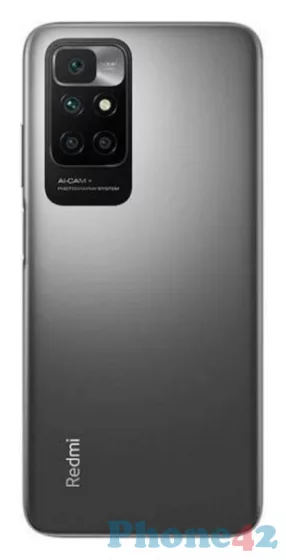
Xiaomi Redmi 10 (2021)
The manufacturer offers this phone with a 6.5 inch IPS display, a Mediatek Helio G88 SoC, and 4 GB of RAM.
Is this phone worth its price? Hopefully, it will become clear by the end of my review.
Table of Contents
- Xiaomi Redmi 10 specifications
- Weight, dimensions, colors
- System, chipset, performance
- Display type, size, resolution
- Memory, storage
- Cameras, flash
- Connectivity, network, wireless
- Battery type, capacity, charger
- Features, sensors, specials
- Verdict, pros and cons
This article shares our personal experiences and thoughts about using the Xiaomi Redmi 10 smartphone. We hope to offer helpful insights to others interested in this device.

Xiaomi Redmi 10 specifications
| Brand | Xiaomi |
|---|---|
| Name | Redmi 10 |
| Model | REDMI10 |
| Release date | 2021 |
Weight, dimensions, colors
| Weight | 6.38 oz |
|---|---|
| Dimensions | 6.38 x 2.97 x 0.35 inch |
| Colors | gray, sea blue, white |
| SIM type | Nano SIM |
The weight of Xiaomi Redmi 10 is about 6.38 oz with battery. This is average for smartphones of the same size. Smartphones use a Nano SIM as a small chipcard for a subscriber identity module (SIM).
System, chipset, performance
| OS version | Android OS v11.0 |
|---|---|
| SoC | Mediatek Helio G88 |
| CPU | Octa-core, Dual-core 2 GHz Cortex-A75, Hexa-core 1.8 Ghz Cortex-A55 |
| GPU | Mali-G52 MC2 |
| Performance | AnTuTu v9: 206678 |
The Xiaomi Redmi 10 comes with Android OS v11.0 out of the box. Google has integrated many services with Android. These include Google Maps, Gmail, and Google Drive. It's a powerful Mediatek Helio G88 octa-core processor. It can handle complex tasks and run many applications. Many mobile devices use ARM Mali GPUs. They are well known for their good performance and power efficiency. We use AnTuTu app to measure general processing performance. AnTuTu Benchmark is the most popular benchmark app for Android phones.
Display type, size, resolution
| Display type | IPS |
|---|---|
| Screen size | 6.5 inch |
| Resolution | 1080 x 2400 px |
| Multitouch support | yes |
The 6.5 inch IPS display has better features. These include optimal viewing angles, color accuracy, and unchanging color reproduction. The 6.5 inch display should be big enough for our needs. It will make viewing comfortable. This is true whether we're reading, browsing, or watching. The size of the screen is measured diagonally, from corner to corner.

Memory, storage
| RAM | 4 GB |
|---|---|
| Internal storage | 64 GB |
| Memory card slot | microSD |
The Xiaomi Redmi 10 comes with 4 GB of RAM, which is considered to be sufficient for most users' needs. Having more RAM alone does not guarantee better performance. 64 GB of storage is usually seen as good for a smartphone. It should be enough for most users. We can expand the internal storage (64 GB) with a compatible microSD card.
Cameras, flash
| Main camera | 64 + 8 + 2 + 2 MP, 9280 x 6920 px, autofocus |
|---|---|
| Flash | LED |
| Selfie camera | 8 MP |
Multiple cameras or depth sensors can help the smartphone. They can make its portrait mode effects more appealing. The Redmi 10 does not have optical image stabilization (OIS).
Connectivity, network, wireless
| GSM 2G bands | 850 / 900 / 1800 / 1900 |
|---|---|
| Network coverage | 2G / 3G / 4G |
| Wi-Fi | Wi-Fi 802.11 a/b/g/n/ac |
| Bluetooth | v5.0, A2DP |
| GPS | A-GPS, GLONASS, Beidou |
| NFC | no |
| FM radio | yes |
| USB | USB Type-C |
| Headphone | 3.5 mm jack |
The Xiaomi Redmi 10 supports 4G/LTE networks. This phone like all modern smartphones, is capable of connecting to Wi-Fi networks. The Redmi 10 smartphone is capable of connecting to Bluetooth devices. This phone has a built-in GPS. The phone isn't NFC (Near Field Communication) capable. NFC is not essential for basic phone functionality, but it can be useful. The 3.5 mm headphone jack allows us to connect wired headphones or earphones to the device.
Battery type, capacity, charger
| Type | Li-Ion 5000 mAh, non-removable |
|---|
The Li-Ion 5000 mAh, non-removable battery gives the smartphone a good battery backup. The Li-ion is a low maintenance battery. It does not need periodic full discharge. The battery of Redmi 10 isn't removable without voiding the warranty.
Features, sensors, specials
| Sensors | accelerometer, compass, fingerprint, light, proximity |
|---|---|
| Specials | Dual SIM, Fast charging, MIUI 12, Quick Charge |
Today, smartphones come with many sensors. They help make the user experience better. The accelerometer provides information about the smartphone's movement in three axes. These are X (horizontal), Y (vertical), and Z (depth). The Redmi 10 phone has a fingerprint scanner. The light sensor detects the level of light in the environment. Dual SIM is great for businesses. They want to give staff a device with separate numbers and bills for personal and business use. The fast charging technology comes in handy when we need quick juice on our device.
Verdict, pros and cons
Every phone has its strengths and weaknesses, and this Xiaomi phone is no exception. As with any device, there are aspects that shine and others that fall short. By examining both sides, we can paint a complete picture of what this phone has to offer. Let's explore its standout features and areas for improvement. Remember, this is just my opinion, and yours might be different.
Pros
- appropriate screen size
- adequate memory
- microSD slot
- multicamera setup
- good battery
- Dual SIM support
Cons
- weak performance
- no OIS function
- no 5G support
- no NFC feature
Please let us know if you find incorrect information or something isn't working. Also, tell us if you have a suggestion for improvement.
Updated: May 11, 2024
 I'm Lucas Bradley, the founder of the Phone42.com site. I love technology, especially smartphones, and I've been working with tech stuff for more than 20 years. This means I've seen a lot of changes and have learned a bunch about what makes a good phone. On Phone42.com, I look at all kinds of phones. They can be from big, well-known companies or new ones trying to make their mark. I want to help people understand what's new and cool in the world of smartphones, in a way that's easy to get.
I'm Lucas Bradley, the founder of the Phone42.com site. I love technology, especially smartphones, and I've been working with tech stuff for more than 20 years. This means I've seen a lot of changes and have learned a bunch about what makes a good phone. On Phone42.com, I look at all kinds of phones. They can be from big, well-known companies or new ones trying to make their mark. I want to help people understand what's new and cool in the world of smartphones, in a way that's easy to get.